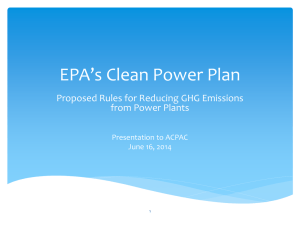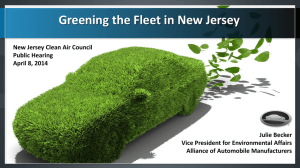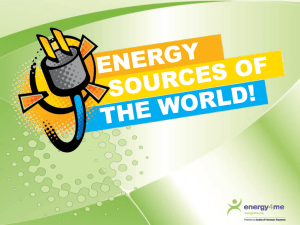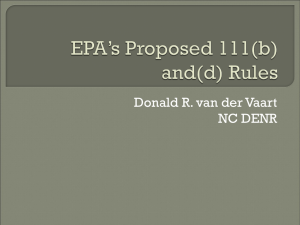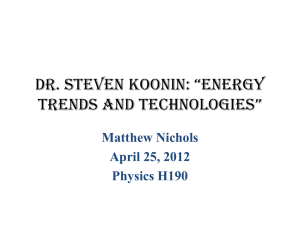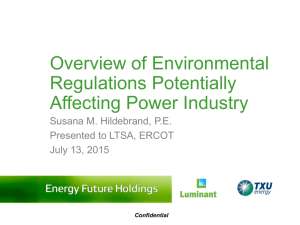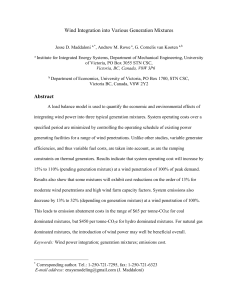Gary Radloff - RENEW Wisconsin
advertisement
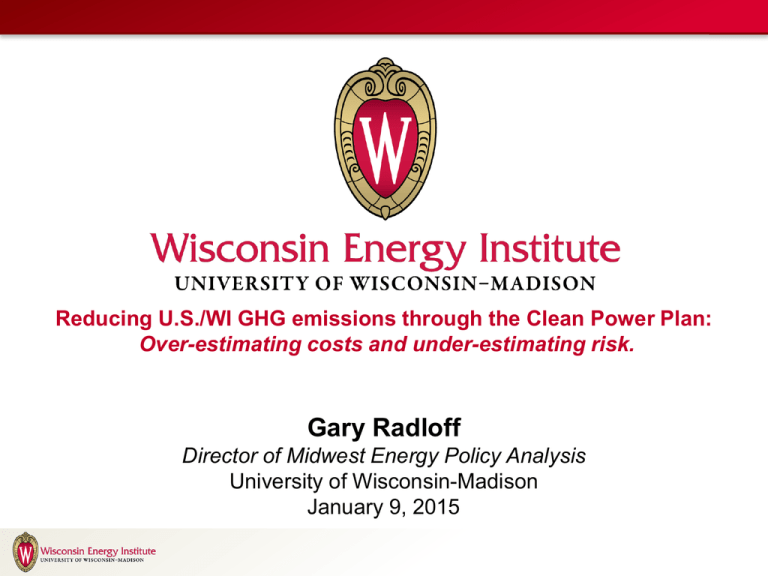
Reducing U.S./WI GHG emissions through the Clean Power Plan: Over-estimating costs and under-estimating risk. Gary Radloff Director of Midwest Energy Policy Analysis University of Wisconsin-Madison January 9, 2015 Key Themes • Today, Wisconsin has highest energy costs under status quo business-as-usual • Long-term risks with total fuel switch to natural gas • Savings can be realized by using greater energy efficiency measures starting today • Savings can be realized by using more renewable energy starting today • Clean Power Plan is the best U.S. opportunity for improved energy efficiency and clean fuels WI Leads US in nominal increase by Percent Avg kWh price 1997 -2013 (Lesser & O’Connor Electricity Journal) Natural Gas is not silver bullet energy solution and fails sustainable test • What is the real supply? How does that balance with the demand? • What is the cost on the global market? • Environmental challenges with water and location. Large Infrastructure investment. • Even with more sources is it a wise idea to waste it? • Remember the US “wasted” its dome oil. We Don’t Know the Future Costs? Natural Gas: How much really? $130 B to $ 210 B Infrastructure Needs Source Interstate Natural Gas Association of America Natural Gas Environmental and Economic Risks • Methane Emissions Higher Than EPA Estimates • Methane Leakage Across the Supply Chain Higher Than Once Thought • GHG Reductions Less Than Current Claims • Too much water usage and an unsustainable solution Recent Studies Challenge Benefits of Natural Gas to GHG Reduction • • • • • • • Miller, Scott. et. al. (2013) Anthropogenic Emissions of Methane in the United States. Proceedings of the National Academy of Sciences (PNAS) Vol. 110. No. 50 20018-20022. Office of the Inspector General. Environmental Protection Agency. (2014). Improvements Needed in EPA Efforts to Address Methane Emissions from Natural Gas Distribution Pipelines. Report No. 14-P-0324. July 25, 2014. Schneising, O., Burrows, J.P., Dickerson, R., Buchwitz, M., Reuter, M., and Bovensmann, H. (2014). Remote Sensing of Fugitive Methane Emissions from Oil and Gas Production in North American Tight Geologic formations. Earth’s Future. AGU Publications 10.1002/2014EFOOO265. Online September, 2014. Busch, C. and Gimon, E. (2014) Natural Gas Versus Coal: Is Natural Gas better for the Climate? The Electricity Journal. Aug/Sept. 2014. Vol. 27, Issue 7. Shearer, C. Bistline, J., Inman, M. and Davis. S. (2014). The Effect of Natural Gas Supply on U.S. Renewable Energy and CO2 Emissions. Environmental Research Letters. Environ. Res. Lett. 9 (2014) 09408 (8 pp). Huntington, Hillard. (2013). Changing the Game? Emissions and Market Implications of New Natural Gas Supplies. Energy Modeling Forum. Stanford University. EMF 26: September, 2013. Freyman, Monika. (2014). Hydraulic Fracking and Water Stress: Water Demand by the Numbers. Ceres Water Program Efficiency the cheapest energy resource (Source ACEEE study) EPA Clean Power Plan (aka: Section III (d) of the Clean Air Act) • • • • • • • The proposed Environmental Protect Agency rule (Clean Air Act) when finalized will require 30% reductions of CO2 emissions (2005 levels) from existing power plants by the year 2030. Under the Clean Power Plan, the U.S. Environmental Protection Agency (EPA) has set individual goals for each state. To achieve their individual goals, EPA expects the state implementation plans (“SIPs”) to include a portfolio of one or more of four “building blocks” to create a Best System of Emission Reduction (“BSER”). The building blocks consist of: Building Block 1: Heat rate improvements at fossil fuel plants (e.g., increasing heat rates at coal plants by 6 percent) Building Block 2: Displacing coal-fired steam and oil/gas-fired steam generation by increasing generation from existing natural gas combined cycle (“NGCC”) plants to raise NGCC plant capacity factors to as much as 70 percent) (the “Re-Dispatch Option”) Building Block 3: Substitution of renewable resources and new nuclear facilities, and extension of life of existing nuclear plants that may be shuttered Building Block 4: Demand reduction aimed at 1.5 percent annual electricity sales from 2020-2029 Wisconsin Compliance with EPA Clean Power Act • WI ranks 14th Nationally in reliance on coal plants. • In 2012, coal generated 51% of Wisconsin’s power, compared with a national average of 37%. • WI released 96 million tons of Greenhouse gases in 2011, of which 41% percent came from coal plants. • WI would have to cut greenhouse gas emissions by 34% between 2012 and 2030. The cut would rank WI 23rd—in the middle of the pack—of other U.S. states. • In a 25-page WI comment document to the EPA rule, the state highlights its successful energy efficiency program, Focus on Energy, as reducing CO2 emissions by approximately 7%, and its Renewable Portfolio Standards (10% renewable generation by 2015) as reducing CO2 emissions by 10%. • WI Plan is due to EPA by June 30, 2016 Overview • WI must reduce CO2 intensity to 1,203 lb/MWh by 2030 under EPA’s proposed Clean Power Plan under section 111(d) of the Clean Air Act • DNR, PSC and Gov. Walker have all submitted comments against the EPA proposal citing internal analysis • This independent analysis uses WEI’s MyPower model (developed by Dr. Paul Meier) and a spreadsheet model based on data provided in EPA’s Technical Support Documents to compare two strategies • Natural Gas Fuel Switching vs. 30% by 2030 RPS • Estimate costs, generation mix and associated emissions RPS Implementation & Fuel Mix Comparison of 2030 Fuel Mixes 2% Wood/Biomass 2% 0% Wind 23% Petroleum 3% 10% 23% 0% Purchased Power 17% 2% Wind Solar 8% 0% Nuclear 21% 2% 1% Solar Nuclear Natural Gas Natural Gas LFG/Biogas 16% Petroleum 0% 16% Wood/Biomass 54% LFG/Biogas Hydro Hydro Coal Coal 30% RPS Generation Mix NG Fuel Switch Generation Mix Long-Term Cost Estimates 5.0 4.5 Annual Generation Costs ($ billions) 4.0 3.5 Fuel Switch Stable Prices Fuel Switch Historical Prices 30% RPS Stable Prices 3.0 30% RPS Historical Prices BAU Stable Prices BAU Historical Prices 2.5 2.0 1.5 2015 1.0 2020 2025 2030 Estimate Average Retail Rates 28 WI Average Residential Price (cents/kWh) 26 24 Historical Rate Increase 22 BAU MyPower 30% RPS MyPower 20 Fuel Switch MyPower BAU Excel Model 30% RPS Excel Model 18 Fuel Switch Excel Model 16 14 12 2014 2016 2018 2020 2022 2024 2026 2028 2030 2032 Estimate Average Retail Rates 28 WI Average Residential Price (cents/kWh) 26 24 Historical Rate Increase 22 BAU MyPower 30% RPS MyPower 20 Fuel Switch MyPower BAU Excel Model 30% RPS Excel Model 18 Fuel Switch Excel Model 16 14 12 2014 2016 2018 2020 2022 2024 2026 2028 2030 2032 Generation & CO2 Abatement Costs A 30% by 2030 RPS is a lower cost compliance strategy by the late 2020’s The 30% RPS also delivers CO2 reductions at costs comparable, or lower, than the fuel switching strategy Next Generation Energy Markets • • • • • • • • What is needed in electric markets? Unlock markets (allow experimentation) Spur innovation (a continuous cycle) Harness competition (welcome new partners/Third Parties) Reward efficiency (Performance-based rates) Reward clean technology (Performance-based rates) Allow greater R&D investment (Off rate cases) Plan for change (Long-Term Plans and Regulatory flexibility) Time to rethink a public utility? • Restore the working concept of “public utility” that to make a effective and efficient transition to a new energy economy. • A public utility is an “undertaking” a rethinking of public goals and private industry toward a common sustainable solution. (We are in this together). • Utilities can no longer look at the public as a obstacle, but rather as a source of promise. • Likewise, the public can no longer see utilities as a obstacle to markets and innovation to secure a low-carbon energy future. • An “instrument of the commonwealth” must be built into the notion of a public utility. It can remain a business with shareholders and profits, but a refocusing on sustainability and the public good. • (Background to these concepts found in Boyd, William (2014) Public Utility and the Low-Carbon Future. UCLA Law Review.) Contact Information Gary Radloff Wisconsin Energy Institute University of Wisconsin-Madison gradloff@energy.wisc.edu 608-890-3449 http://energy.wisc.edu/about/people/radloff Estimate CO2 Intensity (MyPower) 2,000 1,800 CO2 Intensity (lb/MWh) 1,600 1,400 1,200 1,000 800 2014 2016 2018 2020 BAU 2022 30% RPS 2024 Fuel Switch 2026 EPA Target 2028 2030 2032 Fugitive Methane Emissions A 30% by 2030 RPS is a lower cost compliance strategy by the late 2020’s The 30% RPS also delivers CO2 reductions at costs comparable, or lower, than the fuel switching strategy Fugitive Methane Calculations Renewable Cost Estimates Assumptions • Statewide electricity demand (MWh) grows at 0.5% annually • Fossil CO2 intensity is based on historical data (about 2,100 lb/MWh for coal, 904 lb/MWh for natural gas, and 3,758 for petroleum). The MyPower model uses unit level data for each power plant. • Nuclear, hydro and petroleum generation holds at current levels through 2030 (spreadsheet model), while coal, gas and renewables (biomass, biogas, solar, wind) are increased to meet the 30% RPS. • Coal generation (MWh/year) is reduced at a fixed rate to meet EPA’s interim and final CO2 intensity targets with natural gas units larger than 50MW ramped up to fill the generation gap Cost of Generation • • • • • • • • • • Coal = $35/short ton ($3/mmBtu) Natural gas = $5/mcf ($5/mmBtu) Petroleum = $95/barrel ($15/mmBtu) Existing Nuclear = $20/MWh Utility-scale PV = $80/MWh Utility-scale wind = $50/MWh Biogas = $100/MWh Biomass = $100/MWh Existing Hydro = $20/MWh Efficiency “Negawatts” = $30/MWh avoided * Solar PPA Prices from LBNL (link) and GTM Research (link) * All other generation costs are derived from EIA’s Annual Energy Outlook

